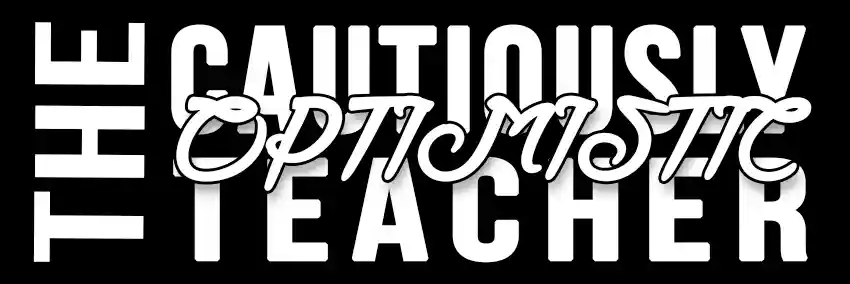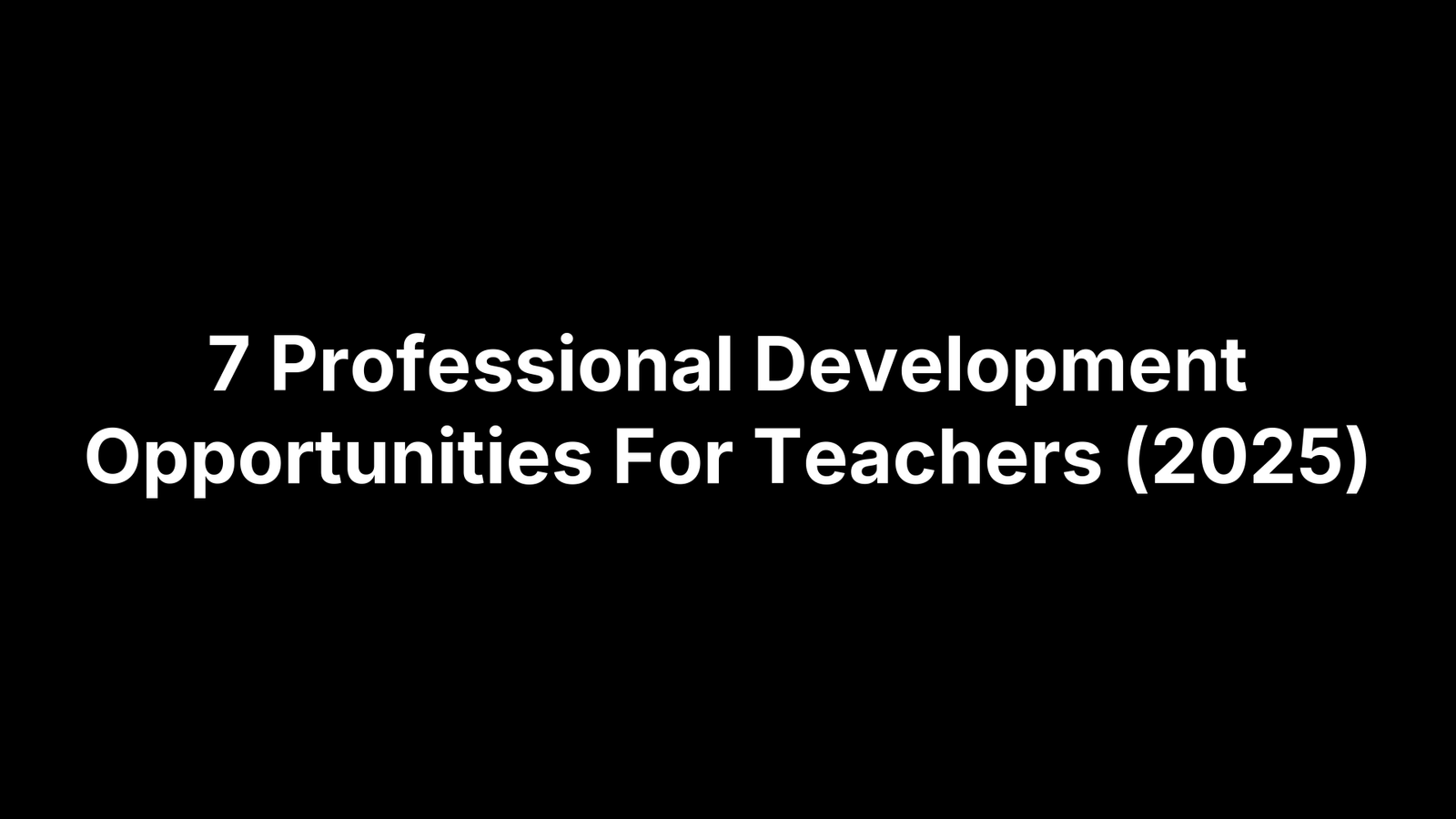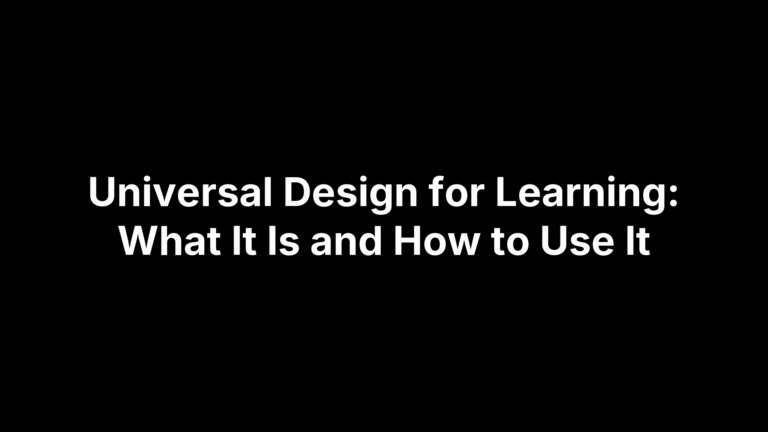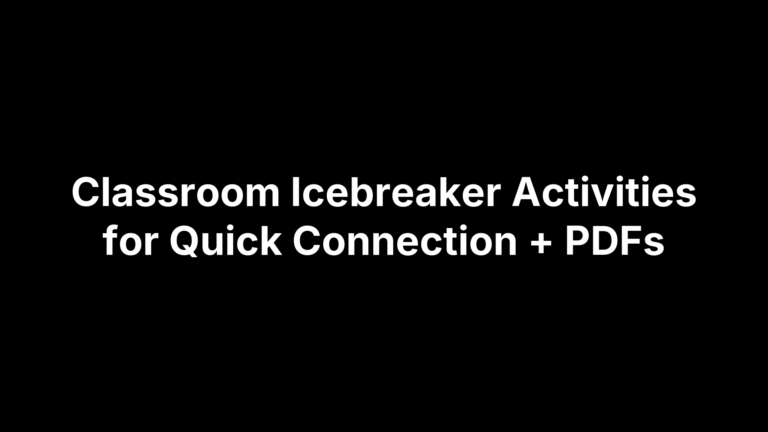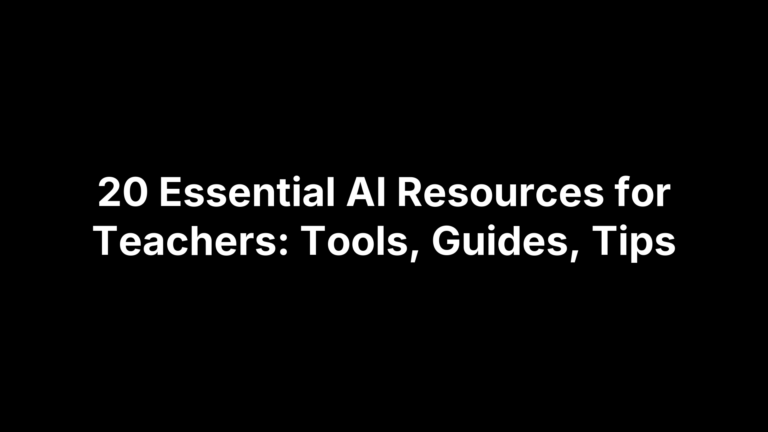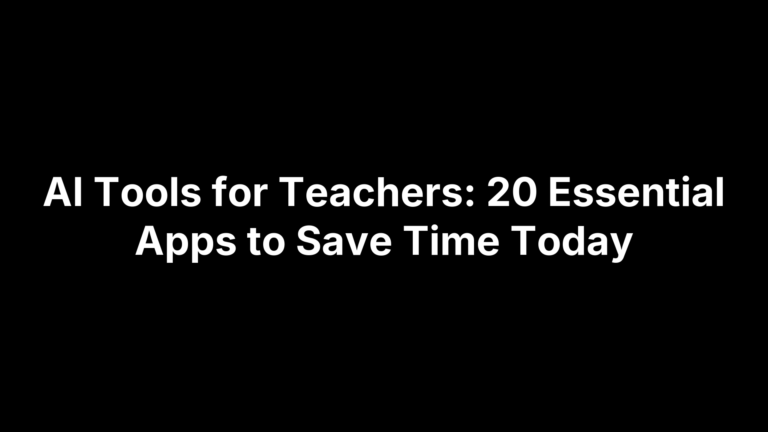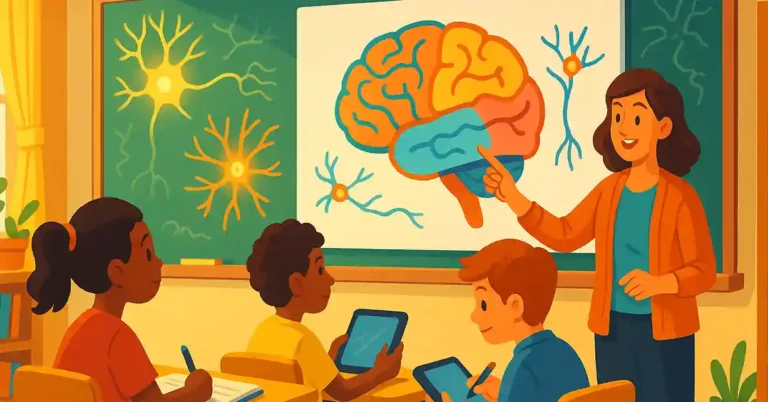7 Professional Development Opportunities For Teachers in 2026
You need professional development that actually makes your teaching better—not another box to check. Between classroom demands, credit-hour requirements, and limited budgets, finding options that are credible, flexible, and worth your time can feel overwhelming. The stakes are real: you want learning that translates into stronger lessons, smoother routines, and more engaged students, while also meeting district and licensure expectations.
This guide narrows the search to seven professional development opportunities for teachers worth your attention in 2025. We’ve curated trusted options across formats and subjects—self-paced resources and AI tools, national micro-credentials, free webinar communities, STEM-focused training, university-backed courses, summer humanities institutes, and an on-demand PD library. For each pick, you’ll get exactly what you need to decide fast: what it is, why teachers like it, format (online or in person), credit/clock hours and time commitment, cost or stipends, and a direct place to sign up. Skim the list, match to your goals, and build a PD plan that fits your calendar—and actually helps your students.
1. The Cautiously Optimistic Teacher: self-paced PD resources and AI tools
What it is
Built by teachers for teachers, The Cautiously Optimistic Teacher is a practical hub of self-paced professional development opportunities for teachers. You’ll find ready-to-use unit plans, classroom routines, and “learning to learn” resources alongside AI-powered tools that speed up planning, differentiation, and feedback—so PD turns into better lessons the same day.
- AI tools: Differentiated Instruction Helper, Worksheet Maker, Question Generator, and Report Card Commentor.
- Classroom resources: Essay writing unit (MLA), Brain Builders Workshop, teacher interview strategies, and differentiated literature/mythology units (e.g., To Kill a Mockingbird, Lord of the Flies, Greek Mythology).
Why teachers like it
Everything is built to be immediately classroom-ready. The mix of strategy posts and AI tools helps you tighten routines, differentiate quickly, and raise the quality of assignments without adding hours to prep. It’s a holistic take on PD—mindset, pedagogy, planning, and workflow—in one place.
Format, credit, and time commitment
This is 100% online and self-paced. Use a single article or tool in a prep period, or implement a full unit over several weeks. Formal credit isn’t issued; many educators document hours as independent study—check district rules for acceptance.
Cost and financial aid
There’s no program tuition or application. Resources and tools are accessed directly on the site; if a specific item has a cost, it will be noted on its page. For reimbursement, save artifacts and reflections aligned to your growth goals.
Where to sign up
Visit The Cautiously Optimistic Teacher homepage to explore resources and join the weekly roundup newsletter for new PD tools and templates delivered to your inbox.
2. NEA professional learning and micro-credentials
What it is
The National Education Association (NEA) offers a broad suite of professional development opportunities for teachers designed for career‑long growth. Through the NEA Center for Great Public Schools, you’ll find workshops, webinars, blended learning, and a robust catalog of micro-credentials (170+ available as of June 2020). Signature offerings include the Teacher Leadership Institute, Aspiring Educators Program, Early Leadership Institute and Early Career Learning Labs (with virtual coaching), Jump Start support for National Board Certification, and resources for cooperating/mentor teachers.
Why teachers like it
NEA’s learning is practical and job-embedded, with options that match real classroom challenges (e.g., SEL, trauma-informed practice, changing demographics). Educators value the credibility, breadth of topics, and the ability to choose pathways that build leadership while strengthening day‑to‑day instruction.
Format, credit, and time commitment
Programs span live webinars, workshops, and blended learning, plus self-paced micro-credentials you can complete on your own timeline. Micro-credentials are competency-focused and classroom-applied; time varies by topic and evidence you submit. Acceptance for clock hours or licensure renewal depends on your state/district—confirm local guidelines before you begin.
- Formats: Webinars, workshops, blended courses, self-paced micro-credentials
- Time: From single sessions to multi-week experiences
- Credit: District/state acceptance varies; check policies
Cost and financial aid
Costs vary by program. Many resources are member-focused, and some offerings are supported in collaboration with partner organizations (e.g., National Board). District reimbursement or union PD funds may be available with prior approval and documentation.
Where to sign up
Go to the NEA Professional Learning pages and search “NEA micro-credentials,” “Teacher Leadership Institute,” or “Jump Start” to review current offerings and enrollment steps. Your state affiliate site may list additional NEA-aligned PD and clock-hour options.
3. edWeb: free webinars and professional learning communities
What it is
edWeb is a free professional online community where educators learn together through webinars, discussions, and collaborative groups. It hosts live and on‑demand edWebinars, workshops, and professional learning communities (PLCs) so you can tap timely topics and practical strategies without leaving your classroom schedule behind.
- What’s inside: Live and recorded edWebinars, discussion forums, courses/workshops, and active PLCs.
Why teachers like it
It’s flexible, relevant, and truly social. You can join a session live or catch the recording later, then keep the learning going in PLCs that share resources, answer questions, and surface classroom-tested ideas. The result is PD that’s easy to start and easier to apply the next day.
- Community-powered: Connect with peers, swap resources, and get real-world answers fast.
- Anytime access: Live streams plus recordings you can watch on your own time.
Format, credit, and time commitment
Everything is online. Most experiences are short webinar-style sessions with options to engage in ongoing PLC conversations. Credit/clock-hour acceptance varies by district and state; verify local rules and document participation with notes, reflections, and implementation artifacts.
- Format: Live and on-demand edWebinars, PLCs, workshops
- Time: Single sessions with optional ongoing community participation
- Credit: Local approval required; check policies
Cost and financial aid
edWeb is free to join and participate. No application fees or tuition; many educators use it as a no-cost addition to their professional development plan.
Where to sign up
Create a free account on edWeb, join PLCs that fit your role or subject area, and register for upcoming live edWebinars—or watch recordings on demand.
4. ORISE K–12 STEM teacher professional development
What it is
ORISE offers free K–12 STEM professional development opportunities for teachers that focus on practical, classroom-ready strategies. The goal is to equip educators with innovative tools and engagement techniques that help students think like scientists and engineers while boosting participation and curiosity in STEM.
Why teachers like it
Educators appreciate that ORISE PD is purpose-built for real classrooms and emphasizes hands-on, student-centered learning. Because offerings are free and STEM-specific, teachers can focus on improving instruction without budget barriers and walk away with strategies they can use immediately with their students.
- STEM-first focus: Training centers on authentic inquiry and problem-solving.
- Actionable tools: Emphasis on techniques that increase student engagement.
- No-cost access: A strong option when your PD funds are tight.
Format, credit, and time commitment
Offerings vary by session. Many are short, focused experiences you can fit between units, with occasional longer-format options. Documentation for clock hours or licensure renewal depends on your state or district—confirm local rules and keep attendance records, notes, and implementation artifacts.
- Format: Sessions and programs provided by ORISE (check current listings)
- Time: From single-session learning to multi-session series
- Credit: Local acceptance varies; verify before you begin
Cost and financial aid
ORISE K–12 teacher PD is free to access. If you need coverage or release time, ask your school about PD funds or reimbursement policies and submit your plan in advance.
Where to sign up
Search “ORISE K–12 teacher professional development” to find the official page, review current sessions, and register. Consider joining their email updates so you don’t miss new STEM-focused offerings that align with your curriculum pacing.
5. Coursera for teachers: university-backed courses and specializations
What it is
Coursera offers university-backed, online professional development opportunities for teachers you can take on your own schedule. Courses span pedagogy, edtech, SEL, and STEM, with optional certificates upon completion. Examples include Foundations of Teaching for Learning, Learning to Teach Online, Negotiating Learner Differences (approx. 15 hours), and Teaching in University Science Laboratories (multi‑module format with videos and readings).
- University-backed: Courses created with reputable universities and organizations.
- Classroom-focused options: From inclusive teaching to lab instruction and online teaching.
Why teachers like it
You get credible content that’s practical enough to use next week and flexible enough to fit between grading and planning. Many offerings build from fundamentals to application, so you can strengthen core practice or dive deep into a niche you teach.
- Flexible and self-paced: Pause, revisit, and learn when it works for you.
- Actionable learning: Assignments and examples map directly to classroom practice.
Format, credit, and time commitment
Courses are fully online with video lessons, readings, and activities; some include peer discussions and projects. Time ranges from short courses (e.g., 15 hours for Negotiating Learner Differences) to multi‑module series. Acceptance for clock hours or licensure renewal varies—confirm with your district/state and document your work.
- Format: Video-based courses with readings/assignments; some multi-course sequences
- Time: Single short courses to multi‑module series
- Credit: Local approval required
Cost and financial aid
Costs vary by course and certificate option. Check each course page for current pricing. Many educators use school or district PD funds for reimbursement with prior approval.
Where to sign up
Create a Coursera account and search for “Foundations of Teaching for Learning,” “Learning to Teach Online,” “Negotiating Learner Differences,” or “Teaching in University Science Laboratories,” or browse “professional development for teachers” to find current offerings.
6. NEH summer institutes and workshops for K–12 educators
What it is
The National Endowment for the Humanities (NEH) funds summer professional development opportunities for teachers through its Division of Education. These competitive programs bring K–12 educators together to study rich humanities topics—history, literature, culture—with scholars and master teachers, often incorporating primary sources and place-based learning.
Why teachers like it
NEH programs deepen content knowledge while modeling inquiry you can take straight back to students. You leave with curated materials, new perspectives, and a national network of colleagues who teach similar content.
- Content-rich focus: Primary sources, scholarly perspectives, classroom-ready materials.
- Collaborative learning: Work alongside educators and humanities experts.
- Immediate classroom payoff: Ideas and resources you can adapt for units next year.
Format, credit, and time commitment
Programs are summer-based and vary by offering; some are intensive short courses while others run longer. Delivery and expectations are outlined by each host.
- Format: Summer institutes and workshops (details vary by program)
- Time: Program-specific (check dates/duration on each listing)
- Credit: District/state acceptance for clock hours or renewal varies; verify locally and document participation.
Cost and financial aid
Funding, participant support, and any materials or travel information are specified on each NEH program page. Review the current call and host site details for what’s covered and what you’ll need to plan for.
Where to sign up
Search for “NEH Division of Education Professional Development Programs” and review the current summer listings for K–12 educators. Each listing includes eligibility, dates, application requirements, and how to apply by the stated deadline.
7. SimpleK12: on-demand PD webinars and certificates
What it is
SimpleK12 is a provider of online professional development opportunities for teachers built around short, practical trainings you can use right away. The catalog spans edtech integration, classroom management, differentiated instruction, and more—with certificates issued upon completion and a sizable on-demand library.
- Breadth of content: 1,500+ on-demand trainings across K–12 grades and subjects.
- Focus areas: Edtech, classroom management, differentiation, and CTE.
- Learning modes: Webinars, virtual workshops, and recorded sessions.
Why teachers like it
It’s fast, focused, and classroom-ready. Sessions zero in on tools and strategies you can implement the same week, and the certificate helps with documenting PD for districts or licensure.
- Certificate on completion: Easy documentation for PD logs.
- Edtech-first lineup: Timely tools and platforms teachers actually use.
- Interactive options: Webinars, forums, and discussions with peers.
Format, credit, and time commitment
Everything is online and self-paced, with live and recorded webinars you can slot between planning blocks. Acceptance of certificates for clock hours or renewal varies by district/state—confirm locally and keep artifacts of implementation.
- Format: Live webinars, virtual workshops, on-demand recordings
- Time: Short sessions you can complete in under an hour; longer series available
- Credit: Provider certificates; local approval required
Cost and financial aid
Pricing and access options are listed by the provider. Many educators secure district PD reimbursement or union support with pre-approval and proof of completion.
Where to sign up
Search for “SimpleK12” to access the official catalog, create an account, and register for upcoming webinars—or start learning from the on-demand library immediately.
Next steps
Pick two opportunities you can start this week and one “stretch” experience for later this year. Confirm what your district accepts for credit, then map deadlines and deliverables on your calendar. As you complete sessions, save certificates, notes, lesson artifacts, and reflections—those pieces make renewal easier and prove impact on student learning.
To keep momentum, block a recurring 45–60 minutes for PD, pair every webinar or course with a small classroom trial, and capture results you can share at your next evaluation or PLC. If you want quick wins that compound, explore the classroom-ready resources and AI tools at The Cautiously Optimistic Teacher to turn learning into better lessons, faster. Your PD should lighten your workload, sharpen your practice, and give students a richer experience—make that your filter for every choice you make this year.
